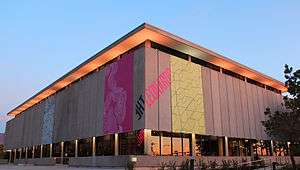The Leonardo (Salt Lake City)
The Leonardo, located in downtown Salt Lake City, Utah, United States is a science and art museum where visitors can explore the ways that science, technology, art, and creativity connect. The museum opened its doors on October 8, 2011.[1]
 The Leonardo, October 2011 | |
%26groups%3D_2e1201ae743376508740f7e2ecb3dfe4dcda0da5.svg)
| |
| Established | October 8, 2011 |
|---|---|
| Location | Salt Lake City, Utah |
| Type | Museum: Interactive, Science & Art |
| Visitors | ~175,000 annually, over 1,000,000 since est. |
| Website | www |
The educational philosophy of the museum is inspired by the Renaissance figure Leonardo da Vinci because of his willingness to follow his curiosity and his general belief that the arts and sciences were a part of the same enterprise. The museum is founded on the idea that Leonardo's approach is even more relevant today, as it has become harder to synthesize the incredible amount of information available to us in the modern age.
The Leonardo is run by a board of directors and an internal staff.[1]
Mission
"It is the Leonardo's mission to fuse science, technology, and art in experiences that inspire creativity and innovation in people of all ages and backgrounds."
History
The Leonardo hosted the Body Worlds 3 exhibition from September 19, 2008 through January 11, 2009.
Exhibits
Flight
Flight is an interactive and immersive exhibit that invites visitors to explore the history, science, art and technology associated with the project of human flight. The exhibit, which opened on August 6, 2016,[2] features several interactive components and displays. The central theme of the exhibit is conveyed by a vibrant tunnel entrance with art and schematics of flying machines and animals that humankind has always dreamed about. As visitors exit the dream tunnel, they find an authentic replica of an American living room on the night of July 20, 1969. There, visitors watch, again or for the first time, the extraordinary moon landing, led by Neal Armstrong and Buzz Aldrin—an event that would spark the wonder of a generation of scientists and pioneers.
At the center of the exhibit is a fully restored C-131 aircraft which only clears the walls on either side of the gallery by a mere 6 inches (15 cm). The exhibit also contains two original flight simulators, made especially for the museum by Rockwell Collins. Flight presents material and interactives that explore three different modes of flight: buoyant, ballistic, and aerodynamic. Flight also includes a space for exploring the unique ways animals take to the skies.

Leonardo's Workshop

Leonardo's Workshop embodies da Vinci's creative obsession with tinkering, design and experimentation. Curated and overseen by the museum's in-house engineer, the Workshop is a dynamic exhibit space that encourages visitors both to identify and solve problems in a variety of different mediums, including wood, metal and plastic. One of the Workshop's more popular components is the marble wall, where visitors can explore the relationship between potential and kinetic energy by building intricate paths for a marble to travel.
Leonardo's Studio
Leonardo's Studio is a longstanding exhibit space that allows visitors to explore the different techniques and technologies that influence art. Visitors can create Claymation films or stop-motion movies — and even experiment with green-screen technology. They can also participate in activities involving painting, sculpting, drawing and craft materials. The Studio is curated and overseen by The Leonardo's in-house artists.
Perception

Perception is an exhibit based on the idea that our minds are astonishing. The human mind constructs experience by distorting, adding, and even leaving things out. By focusing on three senses—touch, hearing and sight—Perception explores how our minds manipulate sensory data to shape a view of the world. Each visit give visitors a new appreciation for that wonderful, mysterious organ, the human brain.
Skin is the largest organ of the human body, a landscape of feeling. In Perception, visitors can navigate the world solely with their sense of touch. They can dive arm-first into the tactile boxes, or try activities that reveal features of their nervous system they never knew about.
See also
References
- Hollenhorst, John (9 Sep 2011). "The Leonardo: More than just a 'museum'". ksl.com. Salt Lake City: Deseret Digital Media. Retrieved 18 Nov 2017.
- Stilson, Amy (5 Aug 2016). "FLIGHT': The Leonardo's original exhibit opens Saturday". ksl.com. Salt Lake City: Deseret Digital Media. Retrieved 18 Nov 2017.